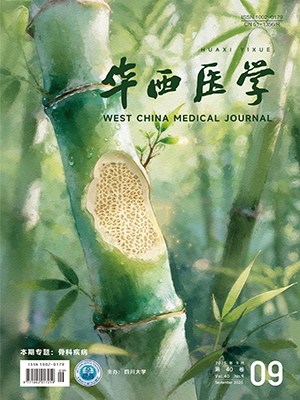| 1. |
Sniecinski I, Seghatchian J. Artificial intelligence: a joint narrative on potential use in pediatric stem and immune cell therapies and regenerative medicine. Transfus Apher Sci, 2018, 57(3): 422-424.
|
| 2. |
王迪, 程金章. 基于機器學習的人工智能技術在耳鼻喉科臨床診療中的應用進展. 山東大學耳鼻喉眼學報, 2021, 35(6): 125-131.
|
| 3. |
Crowson MG, Ranisau J, Eskander A, et al. A contemporary review of machine learning in otolaryngology-head and neck surgery. Laryngoscope, 2020, 130(1): 45-51.
|
| 4. |
齊靜懷, 張良. 人工智能時代的耳鼻咽喉頭頸外科. 臨床耳鼻咽喉頭頸外科雜志, 2020, 34(12): 1137-1140.
|
| 5. |
Wu Z, Lin Z, Li L, et al. Deep learning for classification of pediatric otitis media. Laryngoscope, 2021, 131(7): E2344-E2351.
|
| 6. |
Cai Y, Yu JG, Chen Y, et al. Investigating the use of a two-stage attention-aware convolutional neural network for the automated diagnosis of otitis media from tympanic membrane images: a prediction model development and validation study. BMJ Open, 2021, 11(1): e041139.
|
| 7. |
Bing D, Ying J, Miao J, et al. Predicting the hearing outcome in sudden sensorineural hearing loss via machine learning models. Clin Otolaryngol, 2018, 43(3): 868-874.
|
| 8. |
Wang YM, Li Y, Cheng YS, et al. Deep learning in automated region proposal and diagnosis of chronic otitis media based on computed tomography. Ear Hear, 2020, 41(3): 669-677.
|
| 9. |
王江, 柯嘉, 馬芙蓉. 耳科手術機器人的研究進展. 中華耳鼻咽喉頭頸外科雜志, 2019, 54(12): 944-948.
|
| 10. |
Ozer E, Waltonen J. Transoral robotic nasopharyngectomy: a novel approach for nasopharyngeal lesions. Laryngoscope, 2008, 118(9): 1613-1616.
|
| 11. |
Girdler B, Moon H, Bae MR, et al. Feasibility of a deep learning-based algorithm for automated detection and classification of nasal polyps and inverted papillomas on nasal endoscopic images. Int Forum Allergy Rhinol, 2021, 11(12): 1637-1646.
|
| 12. |
Wu Q, Chen J, Ren Y, et al. Artificial intelligence for cellular phenotyping diagnosis of nasal polyps by whole-slide imaging. EBioMedicine, 2021, 66: 103336.
|
| 13. |
Fang SH, Tsao Y, Hsiao MJ, et al. Detection of pathological voice using cepstrum vectors: a deep learning approach. J Voice, 2019, 33(5): 634-641.
|
| 14. |
胡蓉, 鐘琦, 徐文, 等. 基于深度卷積神經網絡的人工智能在喉鱗狀細胞癌窄帶成像輔助診斷中的應用. 中華耳鼻咽喉頭頸外科雜志, 2021, 56(5): 454-458.
|
| 15. |
Ren J, Jing X, Wang J, et al. Automatic recognition of laryngoscopic images using a deep-learning technique. Laryngoscope, 2020, 130(11): E686-E693.
|
| 16. |
高穎娜, 陳世彩, 王偉, 等. 耳鼻咽喉頭頸外科教學中三維虛擬解剖系統設計. 解放軍醫院管理雜志, 2021, 28(5): 455-456.
|
| 17. |
孫秀偉, 閻麗, 李彥鋒. 虛擬現實技術(VR)在醫療中的應用展望. 醫療保健器具, 2007(5): 17-20.
|
| 18. |
鐘誠, 張學淵, 姜振東, 等. 以學生為中心的耳鼻咽喉頭頸外科學本科臨床教學體系構建及意義. 中華醫學教育探索雜志, 2013, 12(2): 173-175.
|
| 19. |
王承龍, 田勇泉, 梅凌云, 等. 耳鼻咽喉頭頸外科學課堂教學質量的探討與思考. 中國耳鼻咽喉顱底外科雜志, 2013, 19(6): 562-563, 567.
|
| 20. |
Sperry SM, O’Malley BW Jr, Weinstein GS. The university of pennsylvania curriculum for training otorhinolaryngology residents in transoral robotic surgery. ORL J Otorhinolaryngol Relat Spec, 2014, 76(6): 342-352.
|
| 21. |
Curry M, Malpani A, Li R, et al. Objective assessment in residency-based training for transoral robotic surgery. Laryngoscope, 2012, 122(10): 2184-2192.
|
| 22. |
Tseng WH, Lee MS, Wang CC, et al. Objective evaluation of biomaterial effects after injection laryngoplasty - Introduction of artificial intelligence-based ultrasonic image analysis. Clin Otolaryngol, 2021, 46(5): 1028-1036.
|
| 23. |
Ryu S, Kim JH, Yu H, et al. Diagnosis of obstructive sleep apnea with prediction of flow characteristics according to airway morphology automatically extracted from medical images: computational fluid dynamics and artificial intelligence approach. Comput Methods Programs Biomed, 2021, 208: 106243.
|
| 24. |
Jeon Y, Lee K, Sunwoo L, et al. Deep learning for diagnosis of paranasal sinusitis using multi-view radiographs. Diagnostics (Basel), 2021, 11(2): 250.
|
| 25. |
Parmar P, Habib AR, Mendis D, et al. An artificial intelligence algorithm that identifies middle turbinate pneumatisation (concha bullosa) on sinus computed tomography scans. J Laryngol Otol, 2020, 134(4): 328-331.
|
| 26. |
Cho YS, Cho K, Park CJ, et al. Automated measurement of hydrops ratio from MRI in patients with Ménière’s disease using CNN-based segmentation. Sci Rep, 2020, 10(1): 7003.
|
| 27. |
李熠, 匡雙玉, 桂慶軍, 等. 人工智能在醫學生臨床技能培養中的應用探討. 醫學教育研究與實踐, 2018, 26(6): 908-910, 992.
|
| 28. |
Bur AM, Shew M, New J. Artificial intelligence for the otolaryngologist: a state of the art review. Otolaryngol Head Neck Surg, 2019, 160(4): 603-611.
|
| 29. |
Cabitza F, Rasoini R, Gensini GF. Unintended consequences of machine learning in medicine. JAMA, 2017, 318(6): 517-518.
|




